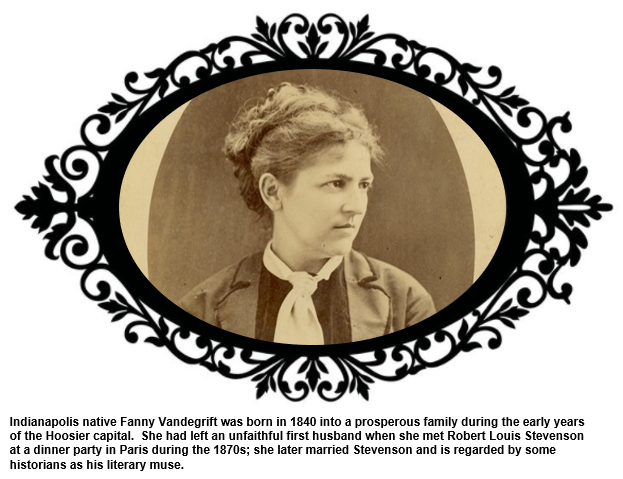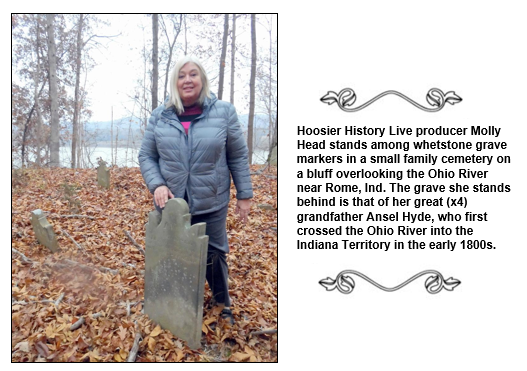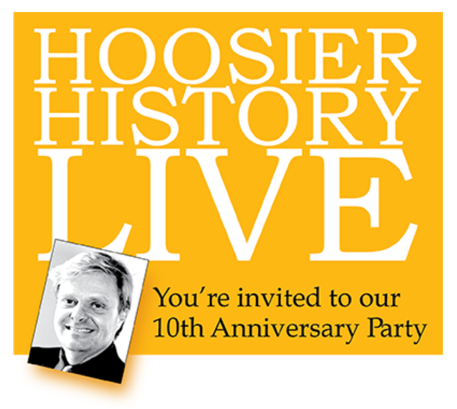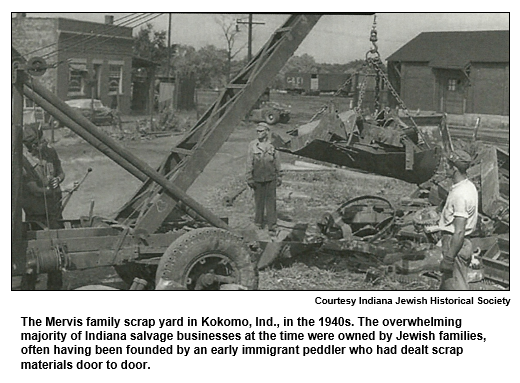Saturdays, noon to 1 p.m. ET on WICR 88.7 FM.
Or listen live from anywhere on WICR Online!
Our call-in number during the show: (317) 788-3314

Jan. 20, 2018
Indy wife of Treasure Island's Robert Louis Stevenson
Unlikely as it may seem, Scottish novelist, poet and essayist Robert Louis Stevenson - author of such classics as Treasure Island (1883) - married an Indianapolis native.
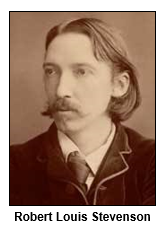
Stevenson, the author of The Strange Case of Dr. Jekyll and Mr. Hyde (1886), wrote most of his best-known works after he met Fanny Vandegrift; some historians even regard her as his muse.
Indianapolis historian Sharon Butsch Freeland, who has researched and written about Fanny Vandegrift's colorful life, will be Nelson’s studio guest.
Fanny's father, a prosperous lumber dealer in Indianapolis, was a close friend of Rev. Henry Ward Beecher, the preacher at Second Presbyterian Church during the 1840s. (Beecher, the brother of Uncle Tom’s Cabin novelist Harriet Beecher Stowe, eventually moved to New York and became one of the best-known clergymen in America.) In fact, Beecher baptized young Fanny in the White River.
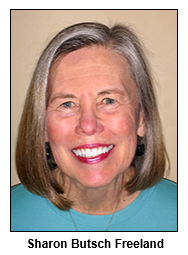
Also unearthed by Sharon: the Vandegrifts owned a farm in Hendricks County, the farmhouse of which still stands. Fanny stayed with her parents at the farmhouse during a rocky period with her first husband, Sam Osbourne, who lived in Nevada and California, where he patronized saloons and brothels, according to historians.
In the 1870s, Fanny and the couple’s three children moved to Europe. She eventually enrolled as an art student at an academy in Paris, where she met Robert Louis Stevenson, who was in frail health. When they married in 1880, she had just turned 40 and he was 29. The couple honeymooned in California, where they decided to live during the first years of their marriage.
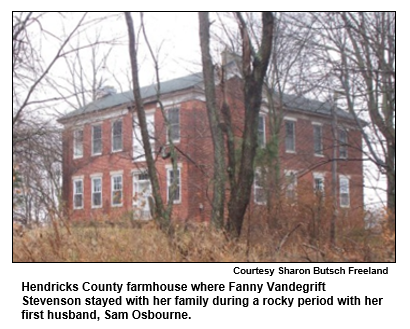
In 1880, the Stevensons moved to Samoa in search of a climate that would provide relief for his respiratory problems. Robert Louis Stevenson died on his village estate in Samoa in 1894 at age 44. Fanny lived until 1914 and is buried next to Stevenson on Mount Vaea, which overlooks the Samoan capital of Apia and its harbor.
Some history facts:
- Our guest Sharon Butsch Freeland has served as a guide for Robert Louis Stevenson devotees visiting from out of state who want to see sites associated with Fanny. They have included California relatives of Sam Osbourne, Fanny's first husband.
- Fanny was just 17 years old when she married Osbourne, who then was working as the secretary to Indiana's governor, according to Sharon's research.
- Before settling in Samoa, the Stevensons "traveled constantly for nearly a decade," Sharon writes. "They spent time in health resorts in England, Scotland, France, the United States and Hawaii."
- According to an article in the spring 2007 issue of Traces, the Indiana Historical Society's magazine, Robert Louis Stevenson and Fanny served an "American-style Thanksgiving dinner" in Samoa a few weeks before he died. During the feast, Stevenson raised his glass and proposed a toast to his Hoosier wife. He said she had been "all in all to me."
History Mystery
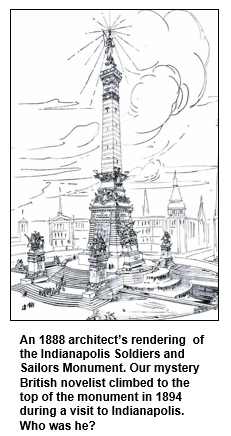
In 1994, on the 100th anniversary of the novelist's visit, a plaque was installed at Union Station, where he disembarked from his train.
Question: Who was the British novelist?
Hint: He created a fictional character who continues to enjoy widespread popularity in modern times. A major motion picture released in 2009 is the most recent of scores of movies featuring the character,
The call-in number is (317) 788-3314. Please do not call in to the show until you hear Nelson pose the question on the air, and please do not try to win if you have won any other prize on WICR during the last two months. You must be willing to give your first name to our engineer, you must answer the question correctly on the air and you must be willing to give your mailing address to our engineer, so we can mail the prize pack to you. The prize is two passes to the Indiana History Center, courtesy of the Indiana Historical Society, and two passes to GlowGolf, courtesy of GlowGold.
Roadtrip: Hindostan whetstone grave markers
Jeannie Regan-Dinius of the Indiana Department of Natural Resources, Division of Historic Preservation, suggests a Roadtrip to seek out pioneer-era tombstones made from Hindostan whetstone. Whetstone grave markers were among the first commercial gravestones used in Indiana; they are made of sedimentary stone quarried from ancient river beds in southwestern Indiana. The term "whetstone" can be traced to the practice of using these flat, smooth stones to sharpen tools.
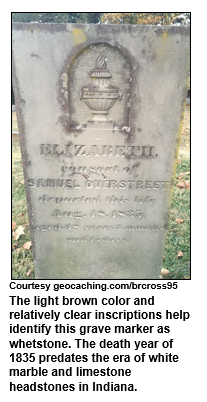
Whetstone grave markers are among the oldest preserved graves in the southern part of the state, and they're not hard to spot in old cemeteries. They usually have a specific tombstone shape (see photo above), and their color is often tan, buff or light brown and streaked with rust (in contrast to the white or off-white of marble or limestone). The inscriptions on whetstone grave markers are usually still legible because the stone's relative softeness allowed for a deep carve; unfortunately, due to the layered nature of the stone, the grave markers are also prone to splitting and flaking away over time.
More than 1,400 whetstone headstones have been identified in cemeteries throughout southern Indiana and southeastern Illinois near the Wabash River. Jeannie tells us that we might find some of these treasures in Greenlawn Cemetery in Vincennes, which is the oldest established cemetery in the state, or in Rose Hill in Bloomington.
Learn more:
- Hindostan Whetstone Tombstone Industry in Indiana. 1811-1860.
- Save-a-Grave: Encouraging Preservation One Tombstone at a Time.
- Geocaching Wolfington Cemetery.
10 years on the air!
Join us March 1 for our anniversary soiree!
Can you believe it? Hoosier History Live has been on the air 10 years.
To celebrate, we are throwing another of our famous anniversary parties!
-
When: Thursday, March 1, 2018, from 5 to 7:30 p.m.
-
Where: Indiana Landmarks Center, 1201 Central Ave., Indianapolis, IN 46202
Featured events at the party will include live "History Mystery" quizzes by host Nelson Price, with fabulous prizes. We are particularly looking forward to brief remarks by Indianapolis mayor Joe Hogsett. And you never know what other notables will be on hand to share remarks and good cheer with our history-loving crowd, which includes listeners, readers and of course many of our distinguished on-air guests.
Nelson Price, host and historian
Molly Head, producer/project manager, (317) 927-9101
Michael Armbruster, associate producer
Cheryl Lamb, marketing and administrative manager
Richard Sullivan, senior tech consultant
Pam Fraizer, graphic designer
Garry Chilluffo, special events consultant

Please tell our sponsors that you appreciate their support!

 Acknowledgments to Monomedia, Visit Indy, WICR-FM, Fraizer Designs, Heritage Photo & Research Services, Henri Pensis, Chris Shoulders and many other individuals and organizations. We are an independently produced program and are self-supporting through organizational sponsorships and individual contributions. We do not receive any government funding. Visit our website to learn how you can support us financially. Also, see our Twitter feed and our Facebook page for regular updates.
Acknowledgments to Monomedia, Visit Indy, WICR-FM, Fraizer Designs, Heritage Photo & Research Services, Henri Pensis, Chris Shoulders and many other individuals and organizations. We are an independently produced program and are self-supporting through organizational sponsorships and individual contributions. We do not receive any government funding. Visit our website to learn how you can support us financially. Also, see our Twitter feed and our Facebook page for regular updates.
Thank you!
We'd like to thank the following recent, new and renewal contributors whose donations help make this show possible!
- Jo Ellen Meyers Sharp.
- Theresa and David Berghoff.
- Juliet Emanuel.
- Emerson Houck.
- James H. Madison.
- Tom Spalding.
- Robin and Deneice Jarrett.
Jan. 27, 2018 - Upcoming
From the scrap heap of history: the Jewish salvage industry in Indiana
The American dream takes many forms. For many Jewish Hoosiers during the early to middle years of the 20th century, it took the form of the family-owned scrap yard, independently operated and passed down from one generation to the next.
For many of these families, the road from impoverished immigrant to wealth and social prominence was paved with the detritus of an industrial economy: Crushed automobile frames. Mangled copper wiring. Smashed aluminum cans. All were to be melted down and turned into raw materials that fed the booming American economy during the second half of the 20th century.
This week's Hoosier History Live show will explore the prominent role of scrap metal recycling among Jewish families in Indiana. Guest host Mick Armbruster will be joined in studio by three guests, each with a unique perspective on the history of the Jewish salvage industry in Indiana:
Trent Pendley, amateur historian, retired fine jeweler and fifth-generation Hoosier. He is past president of the Indiana Jewish Historical Society and lives in Furnessville in the Indiana Dunes. Trent was a previous guest on Hoosier History Live for a show on Jewish immigration to Indiana. He also wrote the historical novel Toys in the Closet, which is set in a beach home among the Indiana Dunes.
- Marty Kroot of Indianapolis, former owner of K&F Industries salvage business. Marty began working in his family's scrap yard as a teenager and honed his skills over five decades in salvage.
- Joan Wolf of Indianapolis, philanthropist and board member of the Indiana Jewish Historical Society. Inspired by her sister-in-law's work on a book on the Jewish history of Madison, Ind., Joan initiated and coordinated the compilation of Bonds as Strong as Steel: A History of Indiana Scrap Metal Dealers and their Families.
Before a wave of consolidation changed the industry in the late 1990s, almost 90 percent of American scrap yards were owned by Jewish families, a statistic that seems to hold true for Indiana as well. Why did so many prominent scrap businesses in Indiana and the Midwest carry Jewish family names? What was it about salvage that attracted Jewish entrepreneurs and encouraged them to build thriving businesses in this field?
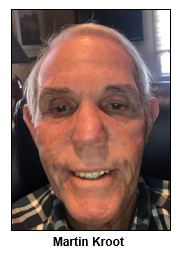
Coming from a tradition of entrepreneurship in the Old Country, Jewish immigrants often were well-suited for the role of peddler in their new homeland, and low start-up costs made the profession accessible to even the poorest among them. In some cases, anti-Semitism played a role in shaping the economic destiny of Jews during the frontier era and early Hoosier statehood; as Trent will explain, Jews were forbidden from owning property in some areas of Indiana, making the nomadic life of the peddler one of their few options for engaging in trade.
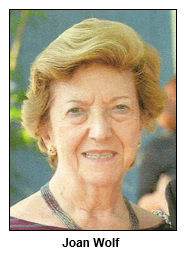
Guests Marty Kroot and Joan Wolf both grew up in Jewish families that owned salvage businesses. We'll hear some of their early memories of the family junk yard, including Marty's experience learning the trade while still a teenager. He cut his salvage teeth at the Alex Cohen’s Sons Inc. scrap yard on the southside of Indianapolis, which his father, the late Sam Kroot, purchased in 1949. Joan will explain the important philanthropic role played by many Jewish scrap business families in Indiana.
Marty also will share his perspective on how the salvage business has evolved over the years, from predominantly family-owned companies to the huge global conglomerates that dominate the industry today.
© 2018 Hoosier History Live. All rights reserved.
|

